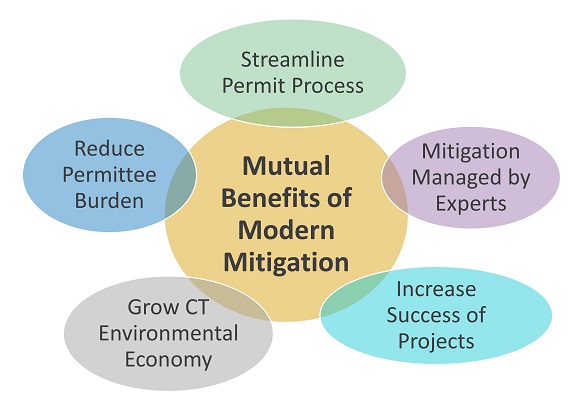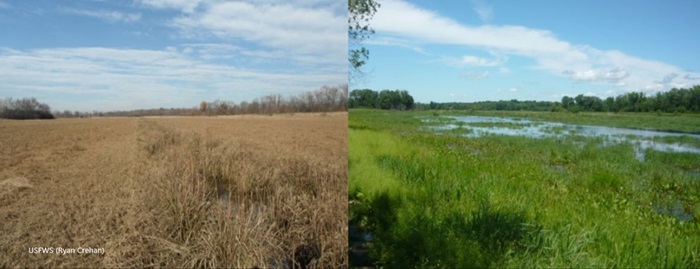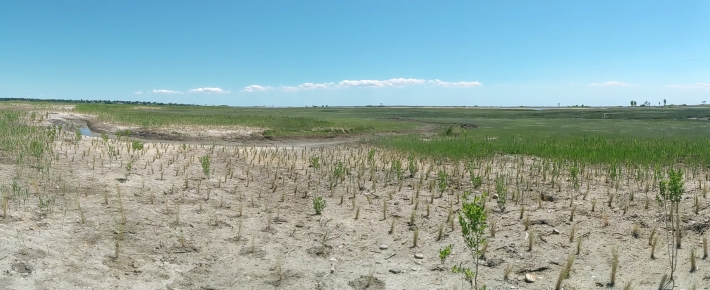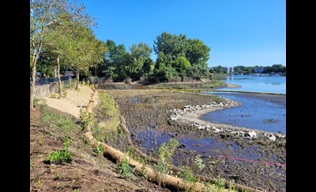Compensatory Water Resource Mitigation
What is Compensatory Mitigation?
Compensatory Mitigation is taking action to restore, create, and/or enhance wetlands and/or other water resources – with a goal of gaining resource area and/or improving resource functions – to compensate for impacts. Mitigation should only occur after resource avoidance and minimization have been achieved to the greatest extent practicable. Compensation for impact is warranted by the Federal Clean Water Act in 33 CFR Part 332, Compensatory Mitigation for Losses of Aquatic Resources, and may be warranted by state or municipal authorities that authorize impacts.
Mitigation Guidance Materials Now AvailableMitigation guidance materials will increase the transparency, consistency, and predictability of mitigation projects. DEEP’s LWRD Division is developing a comprehensive statewide mitigation program to address compensation for impacts to water resources. Program guidance materials are now available in the State Resources section below, to help stakeholders navigate the mitigation process.
What water resource impacts might warrant compensatory mitigation?
DEEP’s Water Resource Mitigation program applies if unavoidable impacts occur to Connecticut’s water resources, including tidal wetlands and other tidal/coastal/navigable waters, intertidal flats, and inland wetlands and watercourses. Impacts to any wetlands, streams, lakes, ponds, pools, or other water types, natural or artificial, may warrant compensation to offset the impact.
- In tidal and coastal areas, DEEP has authority over tidal wetlands and other tidal, coastal, and navigable waters, including tidally influenced waters.
- In inland areas, Connecticut has 191 municipal Inland Wetland Commissions which each hold broad authority over inland water resources inside their respective political boundaries. The exception is that DEEP has authority over State activities, activities on State land, and in State 401 Water Quality Certifications for inland projects that warrant Federal 404 permits.
How does water resource mitigation get done?
- Restoration: Re-establishment of a former wetland or water resource to natural/historic conditions by manipulating the physical, chemical and/or biological characteristics of an area. Restoration results in a gain of water resource area and its associated functions/values.
- Creation: Establishment of a new wetland or other water resource that did not previously exist by manipulating the physical, chemical, and/or biological characteristics of an area. Creation results in a gain of new water resource area and its associated functions/values.
- Enhancement: Improvement of an existing water resource by adding or heightening its functions through manipulation of the physical, chemical, and/or biological characteristics of a resource. Enhancement does not result in a gain of water resource area however it may add to and/or improve existing resource functions/values.
Is compensatory mitigation happening in Connecticut?
Yes, DEEP is requiring some project proponents to provide Permittee Responsible Mitigation, or PRM, to offset resource impacts if they are unavoidable and significant. PRM is compensation that must be provided by the permittee to offset resource impacts, and the mitigation (compensation) gets approved under the same permit as the impacts. With PRM projects, proponents submit a Mitigation Plan in the permit application for DEEP approval, and the permittee is responsible for the mitigation. DEEP is currently working to develop additional mitigation options other than PRM, such as mitigation banking and/or a state in-lieu fee program; these modern programs offer mutual benefits to permittees, staff, and the environment.

To request a mitigation consultation, please email WaterResourceMitigation@ct.gov. DEEP encourages project proponents to consult with staff prior to submitting an LWRD license application to ensure that, if warranted, mitigation is provided in the license application to address proposed impacts. If compensation is needed, a Mitigation Plan [or acceptable equivalent] may need to be submitted for DEEP review and approval.
Mitigation pre-application consultation is recommended if your project proposes permanent impacts to tidal wetlands or intertidal flats, or significant impacts to streams or inland waters [if the project is state activity, state land, or warrants state 401 Water Quality Certification].
In addition to DEEP, municipal inland wetland commissions and the federal USACE may also warrant compensation for loss in Connecticut, under their respective laws, programs and policies.
Mitigation Resources
State Guidance:
CT DEEP is providing the following state guidance materials to assist stakeholders with projects that may require mitigation, to assist in project planning and decision-making and to streamline the development of Mitigation Plans submitted for CT DEEP’s consideration in license applications.
- Mitigation Glossary
- Mitigation Poster
- Mitigation Pre-Application Consultation Form
- Connecticut Mitigation Plan Outline
Federal Guidance:
- Joint Federal Mitigation Rule (USACE/EPA, 2008): CFR Part 332: Compensatory Mitigation for Losses of Aquatic Resources
- Federal Mitigation SOP (USACE, 2024): New England District Compensatory Mitigation Standard Operating Procedures
- EPA Compensatory Mitigation Website
- EPA Compensatory Mitigation Factsheet (2008)
- USACE Compensatory Mitigation Rule Brochure (2008)
Who can I contact with questions about compensatory mitigation?
For mitigation-related questions please email WaterResourceMitigation@ct.gov.
Stay tuned - more mitigation content is coming soon!

Degraded Brides Brook Salt Marsh, Rocky Neck State Park, East Lyme, CT

Mitigation Before/After Photos: Restoring Agricultural Ditch to Wetland

Great Meadows Tidal Marsh Restoration, Stratford, CT
Content last updated August 18, 2025


